
Processing Your Payment
Please do not leave this page until complete. This can take a few moments.
- News
-
Editions
View Digital Editions
Biweekly Issues
- May 13, 2024
- April 29, 2024
- April 15, 2024
- April 1, 2024
- March 18, 2024
- March 4, 2024
- February 19, 2024
- February 5, 2024
- January 22, 2024
- + More
Special Editions
- Lists
- Viewpoints
- HBJ Events
- Business Calendar
- Custom Content
VKTRY aims to boost athlete performance with shoe technology
 PHOTO | CONTRIBUTED
Indianapolis Colts running back Jonathan Taylor
PHOTO | CONTRIBUTED
Indianapolis Colts running back Jonathan Taylor
In a world where every tenth of a second counts and every inch matters, Milford-based VKTRY Gear says it has found a way to give athletes a competitive edge while keeping them healthy.
VKTRY makes and sells sport-specific performance insoles that the company claims helps users run faster, jump higher and stave off injury.

Stephen Wasik, CEO, said the company takes a static product and makes it a “dynamic” one.
“Even though we are primarily an insole company, what we are is a performance company and we make performance gear,” Wasik said.
Using a carbon-fiber design, the insoles, dubbed “VKs,” return energy created by athletes pushing off the ground to increase their speed and vertical leap, according to the company.
VKTRY’s products have captured the attention of several pro athletes and elite-level sports teams.
According to Wasik, the insoles are being used by more than 200 pro and college teams. The brand has received backing from Louisiana State University’s Director of Athletic Training Jack Marucci and now-retired Lakers trainer Gary Vitti, among others.
VKTRY has been approached by several pro athletes offering to be spokespeople. That includes NBA Hall of Famer Tracy McGrady, Cleveland Browns running back Nick Chubb and Indianapolis Colts running back Jonathan Taylor.
“When I first put VKTRY Insoles into my cleats, it was an instant boost of explosion, power and speed. Being able to explode out of my cuts with more power helps me separate from a defender,” said paid spokesman Taylor, in a 2021 article acknowledging his support of the company.
VKTRY Gear employs 14 people out of its 4,000-square-foot facility at 135 Research Dr. in Milford.
VKTRY Gear has also done a mix of capital-raising in recent years. The company raised $2 million in capital in 2019 and 2021, respectively, which has gone towards driving growth.
Wasik indicated that most of the capital was raised from angel investors, many of whom are from Connecticut.
While he notes that the company isn't planning to raise capital in 2023, Wasik suggests that future efforts are likely.
From Olympics to weekend warriors
Wasik and company president Matthew Arciuolo launched VKTRY Gear in 2016, more than a decade after Arciuolo developed the patented insole.
The VK was initially a product Arciuolo created when he worked with Team USA’s Olympic bobsled team in 2005.
A certified pedorthist (a professional trained to treat foot, ankle and lower extremity conditions with devices such as footwear), Arciuolo said he developed the insole to improve speed and explosiveness takeoff by a hundredth-of-a-second.
"That can be the difference between a gold medal and a 10th place," said Arciuolo, who believes his invention helped the team win gold in Vancouver.
Now seven years since its inception, Wasik says the company has blossomed by targeting young athletes, primarily in high school.
“The business has really taken off,” he said.
According to Wasik, VKTRY saw total sales increase more than 40% over the past two years, thanks largely to an increase in traffic to its e-commerce site driven by several viral videos that VKTRY insoles were featured in on social media.
Among them is a video of Drew Arciuolo, VKTRY’s head of marketing, demonstrating the benefits of using VKs to high school athletes.
The video, which has been viewed more than 15 million times on TikTok, shows athletes watching with surprise as Arciuolo folds and launches a sneaker loaded with VKs from the ground to the ceiling.
At one point during the clip an athlete performs a vertical jump of 40 inches in the air – which the athlete says is five inches higher than he achieved without the VK.
Wasik says that the uptick in attention that the company received from its social media marketing helped the company boost its sales by more than 80% in the fourth quarter of 2022, up from its sales in Q4 last year.
While he declined to disclose specific figures, Wasik notes that 2022 was VKTRY’s best year in sales as the company sold its 115,000th pair of VKs by the end of the year.
The company offers three categories of VKs at different price points. The gold VKs – the original design – cost $169; a more cost-effective model for “casual athletes” – the Silver VK – sells for $99.
For people who require more fit and support, VKTRY Gear offers the $399 Platinum VK personalized to an individual athlete.
Coming off their best year in sales, Wasik said he and Arciuolo are eyeing additional growth in 2023, with hopes of increasing revenue by more than 50%.
Overcoming the hurdles
While VKTRY is enjoying its day in the sun, Wasik admits that the company faced significant hurdles at the outset of the coronavirus pandemic in 2020.
“That was devastating for us because team sports and schools were closed down,” he said, adding that VKTRY saw a 20% decline in sales in 2020.
The company pivoted toward older consumers during the pandemic, targeting individual sports and activities like running, fitness and golf, among others.
That proved beneficial for the company, which grew its sales by roughly 15% from 2020 to 2021.
“By doing so, we were able to survive the pandemic,” Wasik said of the pivot.
Educating consumers about their product is another challenge the company has been working to address.
“The last time we did a survey, we saw that our product only had a 5% awareness rating, so we know there are 95% of athletes who can still discover the product,” he said.
The company has tried to mitigate its consumer-education challenge through independent studies showing the benefits of its carbon-fiber insoles.
One such study, conducted by Southern Connecticut State University, found that, on average, athletes who used VK’s product saw a slightly more than 9% increase in what the company termed “athletic explosiveness” when jumping and running.
That was evident in several studies with roughly 77 college and high school athletes summarized by VKTRY in September 2020.
A 2016 study conducted by Barwis Methods in Florida found participants cut 0.12 seconds off their 40-yard-dash time, while a UConn study found that participants added 1.5 inches to their vertical jump using the product the following year.
Beyond the data, athletes tell New Haven Biz that they’ve experienced noticeable differences in their athletic performance once they started using VKs.
Dallas resident John Ranello has been a personal trainer for 50 years, but began using VKTRY insoles six years ago. At 72, he says that he is training harder without injuring himself.
“My goal is to try to sustain my athleticism and peak performance for as long as I’m capable of doing it,” he said.
Ranello learned about VKTRY through one of his workout partners, whose son played at the University of Oklahoma.
“One of their coaches mentioned VKTRY insoles to my friend and he told me about it and I looked them up,” he said, adding that he was looking for something that would allow him to maintain his health and continue his love for sports and fitness.
“Prior to using VKs, every time I sprinted or ran on the basketball court, my hips hurt, my knees ached and I had to constantly ice my knees and hips just to feel better,” Ranello explained. “But, after using VKTRY for about six years, I haven’t had to ice again and I am probably training much harder now than I did six years ago.”
Aside from training clients at the Dallas Jewish Community Center, Ranello said he still plays sports like football and basketball and trains regularly, achieving personal bests in different activities.
“I’m 72 years old and I’m still running a 5.4 (second) 40-yard dash, which is pretty fast for an old guy,” he says. “Fifty years in the health club business, I know what works and what doesn’t work."

Most Recent

2022 Giving Guide
This special edition informs and connects businesses with nonprofit organizations that are aligned with what they care about. Each nonprofit profile provides a crisp snapshot of the organization’s mission, goals, area of service, giving and volunteer opportunities and board leadership.
Learn more
Subscribe
Hartford Business Journal provides the top coverage of news, trends, data, politics and personalities of the area’s business community. Get the news and information you need from the award-winning writers at HBJ. Don’t miss out - subscribe today.
Subscribe
2024 Book of Lists
Delivering Vital Marketplace Content and Context to Senior Decision Makers Throughout Greater Hartford and the State ... All Year Long!
Read Here-
2022 Giving Guide
This special edition informs and connects businesses with nonprofit organizations that are aligned with what they care about. Each nonprofit profile provides a crisp snapshot of the organization’s mission, goals, area of service, giving and volunteer opportunities and board leadership.
-
Subscribe
Hartford Business Journal provides the top coverage of news, trends, data, politics and personalities of the area’s business community. Get the news and information you need from the award-winning writers at HBJ. Don’t miss out - subscribe today.
-
2024 Book of Lists
Delivering Vital Marketplace Content and Context to Senior Decision Makers Throughout Greater Hartford and the State ... All Year Long!
ABOUT
ADVERTISE
NEW ENGLAND BUSINESS MEDIA SITES
No articles left
Get access now
In order to use this feature, we need some information from you. You can also login or register for a free account.
By clicking submit you are agreeing to our cookie usage and Privacy Policy
Already have an account? Login
Already have an account? Login
Want to create an account? Register
Get access now
In order to use this feature, we need some information from you. You can also login or register for a free account.
By clicking submit you are agreeing to our cookie usage and Privacy Policy
Already have an account? Login
Already have an account? Login
Want to create an account? Register






0 Comments